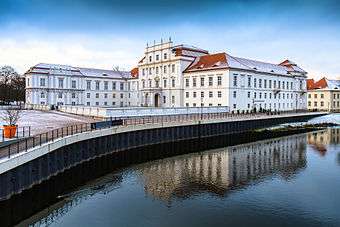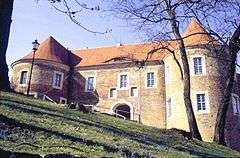Brandenburg
Brandenburg (German: Brandenburg), (Lower Sorbian: Bramborska; Upper Sorbian: Braniborska) is both a historical region and a modern federal-state in Germany. Brandenburg was historically composed of a larger amount of territory now located across the Oder River in western Poland. It is also the heart of historic Prussia and thus borders on the federal capital of Berlin. It shares borders with the German federal states of Saxony, Saxony-Anhalt, Mecklenburg-Western Pomerania, and Lower Saxony. To the east lies the neighboring country of Poland.
- For other places with the same name, see Brandenburg (disambiguation).


Cities
- 🌍 Potsdam — the capital of Brandenburg, bordering Berlin. Widely known for its castles and landscape as a World Heritage Site.
- 🌍 Brandenburg an der Havel — oldest town and "cradle" of Brandenburg; ancient cathedral, churches and other medieval buildings.
- 🌍 Cottbus
- 🌍 Eisenhüttenstadt — the former "Stalinstadt" was founded in the 1950s as a Soviet-style model town for the metalworkers in the region
- 🌍 Falkensee near Berlin
- 🌍 Frankfurt an der Oder — along the Polish border
- 🌍 Ludwigsfelde
- 🌍 Mühlberg
- 🌍 Oranienburg — a quiet suburb housing the remains of one of the few preserved Nazi concentration camps, KZ Sachsenhausen, on German soil. There's also a small palace in the centre of Oranienburg.
- 🌍 Werder (Havel)
Other destinations
.jpg)
Brandenburg is known for its nature.
There is one national park:
- Lower Oder Valley National Park
There are three UNESCO Biosphere Reserves:
- Flusslandschaft Elbe
- Schorfheide-Chorin
- Spreewald.
In addition, there are 11 nature parks:
- Hoher Fläming.
- Nuthe-Nieplitz-Niederung, .
- Westhavelland
- Stechlin-Ruppiner Land
- Uckermärkische Seen
- Barnimer Land
- Märkische Schweiz
- Dahme-Heideseen
- Schlaubetal
- Niederlausitzer Landrücken
- Niederlausitzer Heidelandschaft
Understand
Brandenburg is more or less the countryside around the Berlin metropolitan area. Within less than an hour, you can get out of the huge city and find yourself in the middle of a forest or a pretty village, on the banks of a lovely lake or in front of a medieval church or castle. The major attraction of Brandenburg is the city of Potsdam with its UNESCO world heritage label. However, besides Potsdam, there are plenty of other attractions that make Brandenburg worth the trip. The gray reminders of 40 years of Communist rule are gone, and now Brandenburg offers lots to discover to the visitor.
Brandenburg was once ridiculed as the Reichsstreusandbüchse (roughly: imperial sandbox) due to its sandy ground and low population density and seen as virtually worthless real estate prior to the ascent of Prussia. The population density is still low (at least by German standards) and this along with its history aided in preserving a lot of the nature and wildlife. In the southeast of Brandenburg, along the border with Saxony, the Lausitz was and still is one of Germany's major open pit coal mining areas. Many of the former pits have been converted into lakes, drawing many (mostly domestic) visitors since GDR times.
Talk
People in Brandenburg speak German, possibly with the Berlin-Brandenburg dialect which is relatively close to standard German. Low German dialects are sometimes spoken in rural northern Brandenburg, but almost extinct in most areas. Younger people normally do understand English, while English proficiency among the older generation is usually low. Lower Sorbian, which is similar to and to a certain degree mutually intelligible with Polish and Czech, is spoken in a small region in the southeast bordering Saxony and Poland. The number of native speakers is however low and decreasing. All Sorbs are bilingual and speak perfect German, while only few Germans speak Sorbian.
Get in
By plane
Brandenburg is served by the same airports as Berlin. Tegel International Airport (TXL IATA) is in the north of Berlin, while Schönefeld International Airport (SXF IATA) in the south. Schönefeld Airport will some time in the future be replaced by Berlin-Brandenburg International Airport (BER IATA), while Tegel will likely close after BER is opened; however, BER's opening date has been pushed back many times and as of July 2017, the true opening date remains unknown.
If you are headed for southern Brandenburg the airports of Leipzig/Halle (near Schkeuditz, Saxony (LEJ IATA) and Dresden (DRS IATA) in the neighborhood of Klotzsche, some 15 km or 25 minutes by S-Bahn from the city-center) might be alternatives for you. However, there is generally a wider section of flights to/from Berlin than these airports.
By car
Since Berlin is located in the middle of Brandenburg, there are highways (Autobahn) to all major directions crossing through Brandenburg. Many places in Brandenburg can be reached by car within one or two hours from the center of Berlin.
The following Autobahns run through Brandenburg: A2, A9, A10, A11, A12, A!3, A15. A24 originates in Hamburg and passes through Mecklenburg Vorpommern and goes via Rostock before heading to Berlin.
By public transport
The railway system is oriented towards Berlin. There are frequent regional trains connecting Berlin with all major cities in Brandenburg. However, it is often difficult to get to smaller places via public transport. There are buses, but travelers should check timetables. The Berlin-Brandenburg-Public-Traffic-Network (vbb) co-ordinates public transport in the region. There is also a consistent tariff system, so travelers can buy a ticket for the entire journey even if they change from the train to buses. The website of the Traffic Network vbb offers information on timetables and tariffs.
Get around
The easiest way to get around is by car. There are several highways (Autobahn), that connect Berlin with different German regions - all leading through Brandenburg. In addition, there are well maintained roads.
Public transport to many rural destinations is poor. There are a few railroad connections within Brandenburg and there are public buses, but travelers should check timetables for connections.
See
- Potsdam with its spectacular royal palaces and parks, the Dutch Quarter is a lovely city and a UNESCO World Heritage Site.
- The Spreewald, a unique landscape with hundreds of small irrigation canals, a UNESCO biosphere reserve.
- The wide ranging architecture of Cottbus.
- The medieval windows of the Marienkirche Frankfurt an der Oder.
- Castles and Palaces: There are many smaller and larger rural palaces and castles, some of them are hotels, others museums or private homes; in the Fläming region, there are four medieval castles.
- Historic city centers: many towns in Brandenburg have pretty well kept historic city centers.
Do
- Hiking
- Cycling
Saddle up and explore the Brandenburg-Barnim countryside - you'll get fit too! Traveling around on two wheels you'll see loads more of the county, and with nine cycle routes to choose from there is no excuse for not getting your bicycle out.
- Inline Skating
Eat
Spreewald-Gurken (pickled cucumbers from the Spreewald-region) were a specialty during GDR times and are again growing in popularity.
Drink
Club-Cola is one of two big former East German cola brands.
Stay safe
Brandenburg lacks big cities and therefore also most of their associated crime. However unemployment, low birth rates and general lack of persepctive for young people have hit some rural towns hard, and some have lost half their population since 1990. This along with disilusionment after reunification has led some people to radical political ideas and some of them are violent. A former spokesperson of the German government said prior to the 2006 soccer worldcup that there are "small and medium sized communities in Brandbenburg and elsewhere that he would advise people with other skin colors not to go to, as they might not return with their lives". Obviously this was an exaggeration to get a debate going, and the situation has improved a lot since than (the right wing extremist party for example is no longer represented in the state parliament as they poll well under the 5% threshold), but caution is advised in some areas, especially at night, and especially for people who look "different" or "foreign".
That being said all in all violent crime is extremely rare in Germany as a whole and Brandeburg is no exception. Almost all visitors to Brandenburg never encounter any problems and if you should, the police is usually able and very willing to help you. As the right-wing extremist groups are seen as a huge embarassment to the state's reputation and also something of a tired cliché in inner-German debate, you should exercise some caution when speaking about that topic, as you might get people upset.
Go next
- The Baltic Sea Coast (Germany) in Mecklenburg-Western Pomerania
- Poland is right across the Oder/Odra
- Berlin
- The Lausitz in the south is shared with Saxony